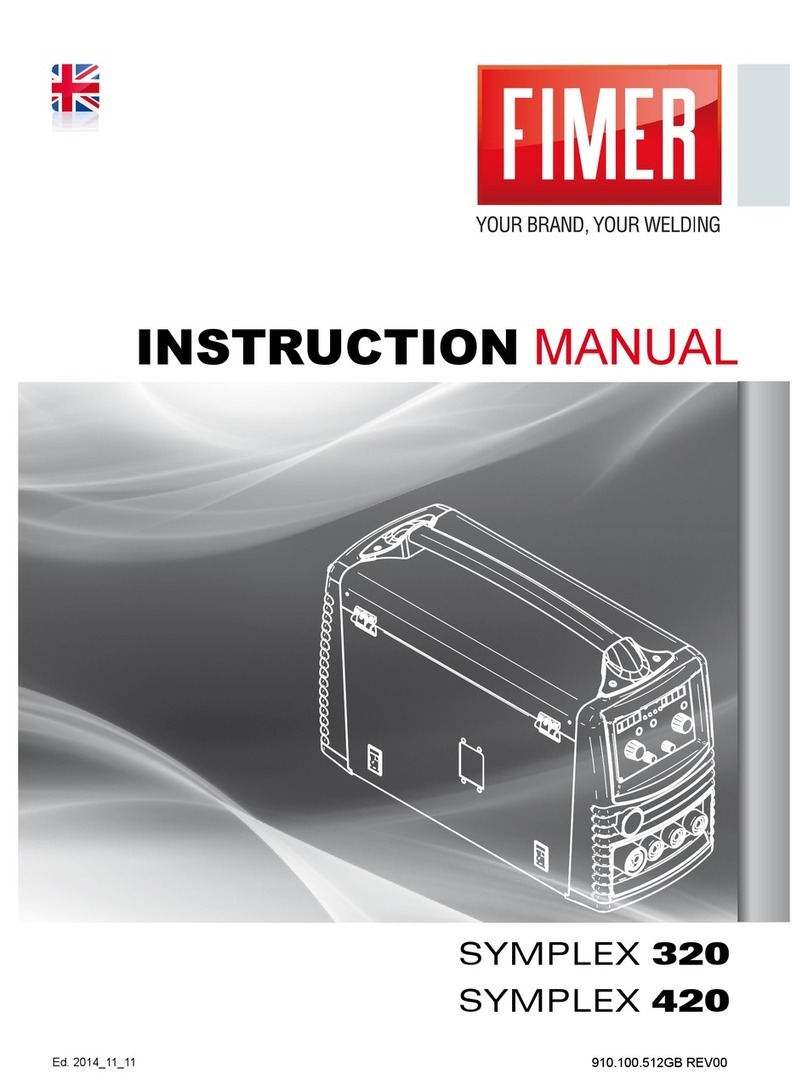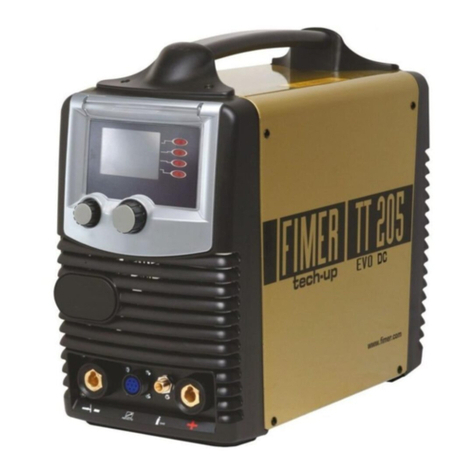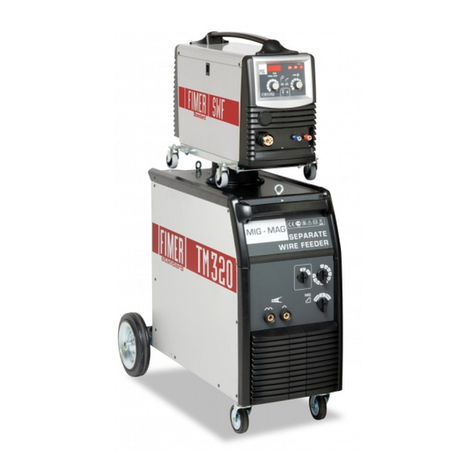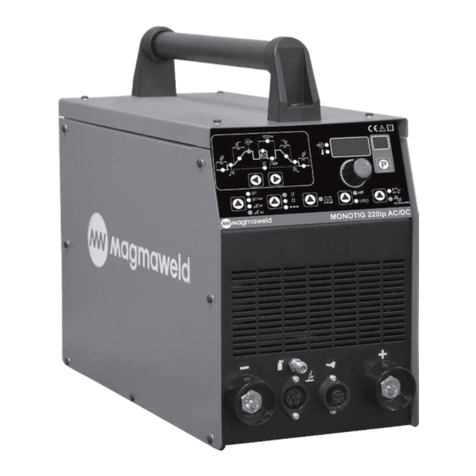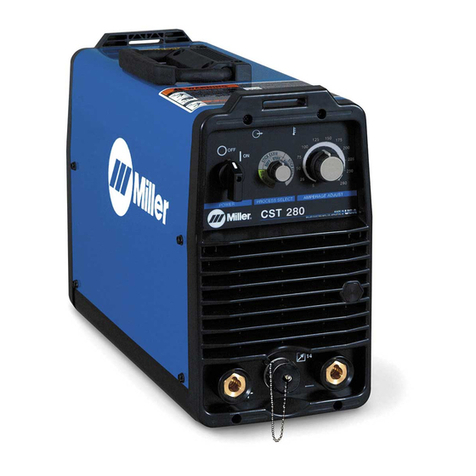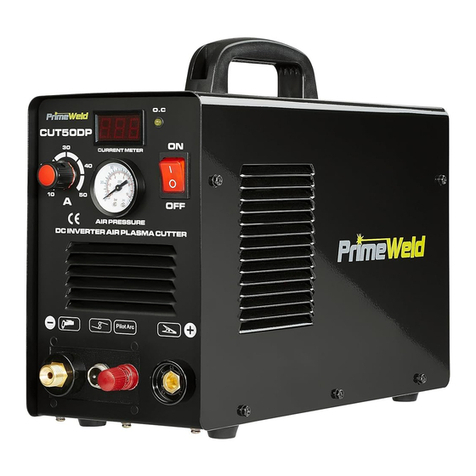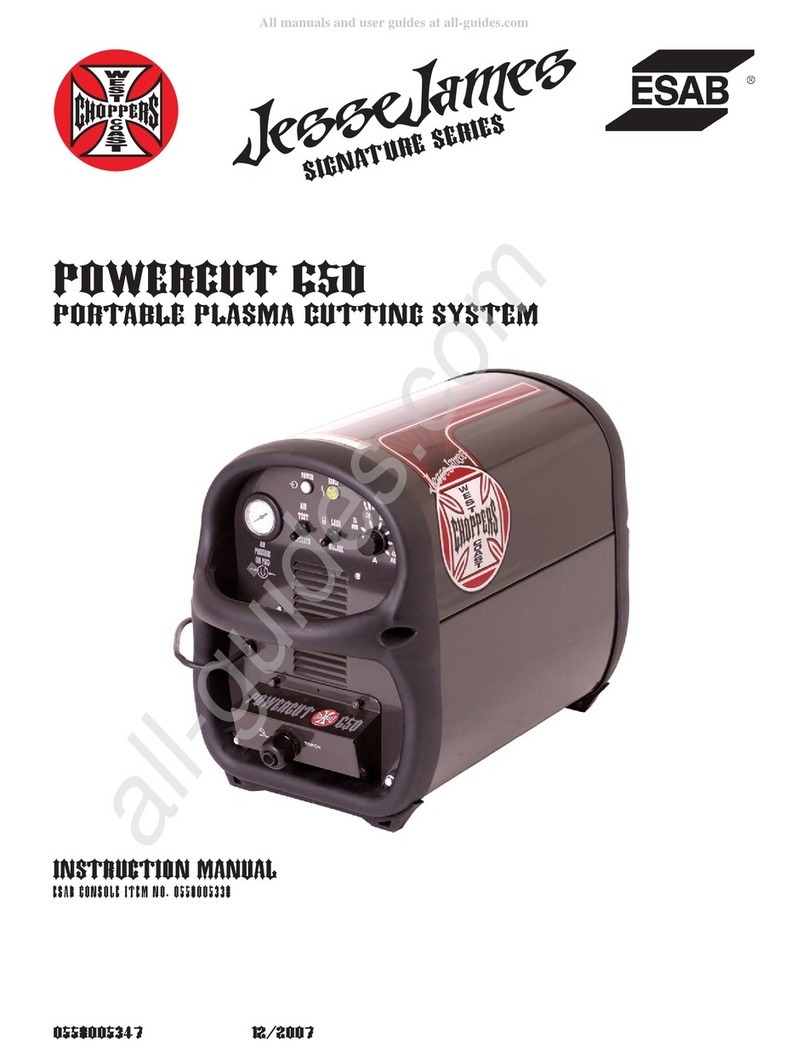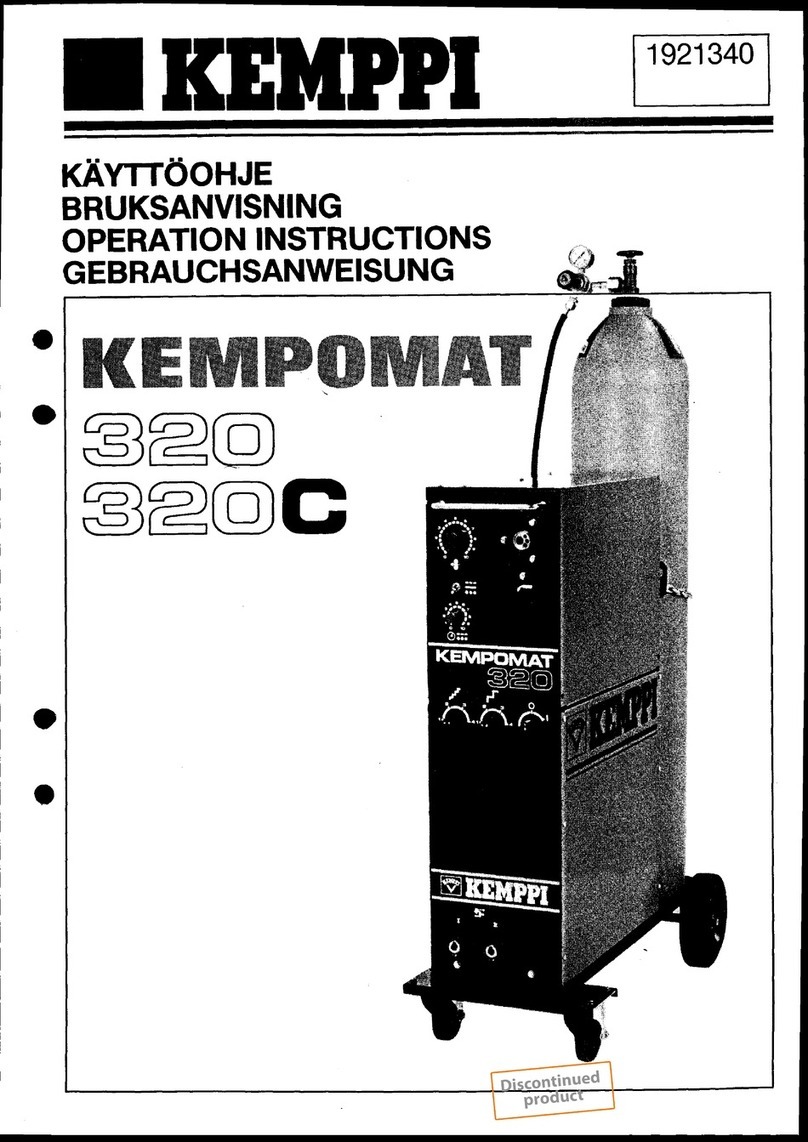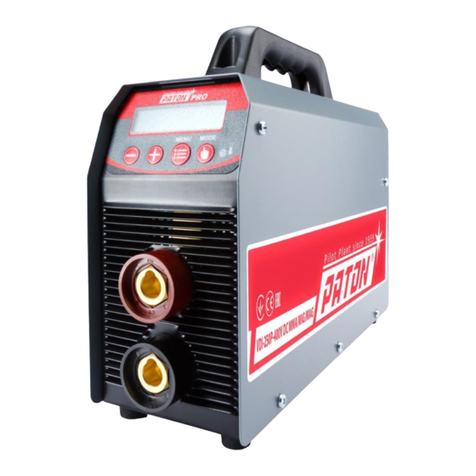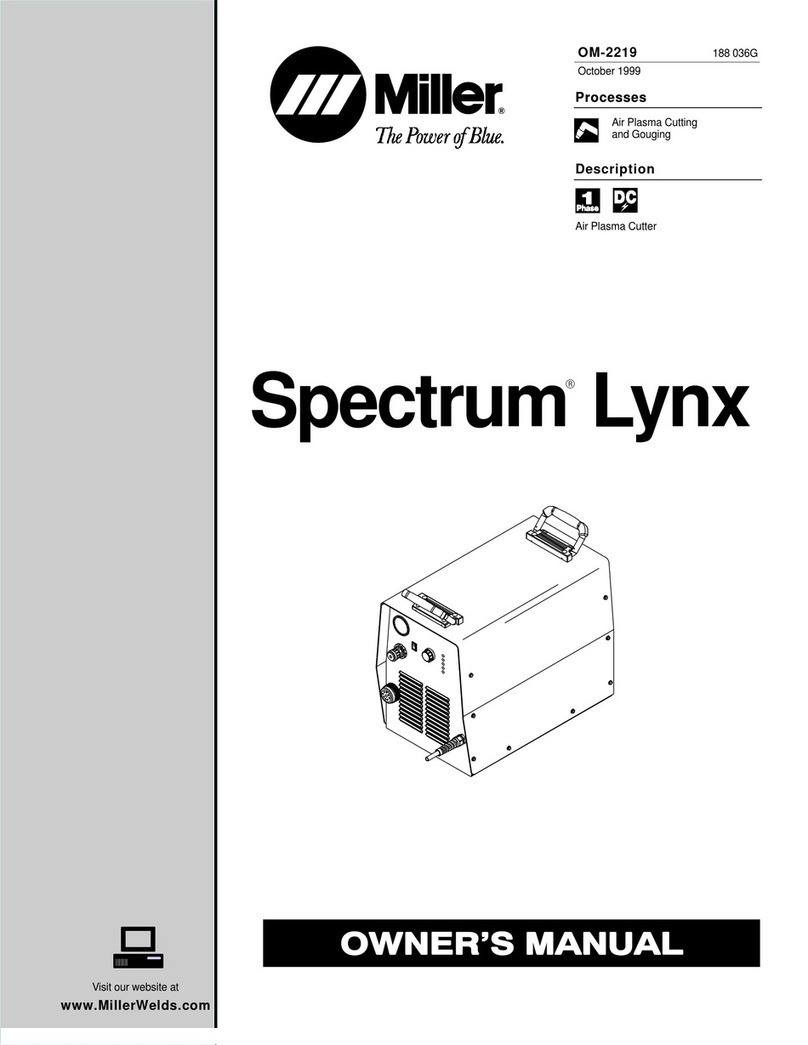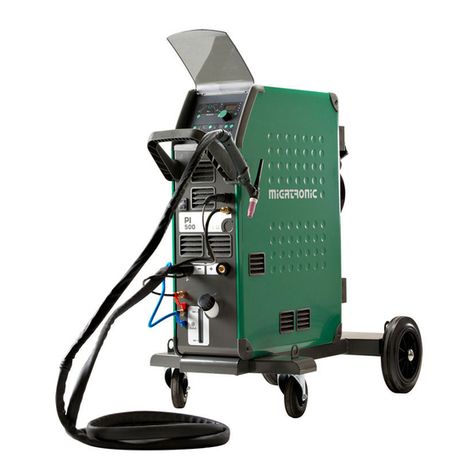Fimer Tp 72 User manual

910.100.276GB REV00 1 di 28
INSTRUCTION MANUAL
.

910.100.276GB REV00 2 di 28

910.100.276GB REV00 3 di 28
WARNING
.

910.100.276GB REV00 4 di 28
.
.

910.100.276GB REV00 5 di 28
.
.

910.100.276GB REV00 6 di 28
1 MANUFACTURER’S NAME, ADRESS AND COMPANY
LOGO
2 MODEL
3 SERIAL NUMBER
4 BLOCK DIAGRAM
5 TYPE OF WELDING
6 SUITABLE FOR USE IN AN ENVIRONMENT WITH
INCREASED HAZARD OF ELECTRIC SHOCK.
7 POWER SUPPLY
8 PROTECTION DEGREE
9 TYPE OF WELDING OUTPUT CURRENT
10 RATED NO-LOAD VOLTAGE
11 RATED INPUT VOLTAGE
12 MAXIMUM RATED INPUT CURRENT
13 MAXIMUM EFFECTIVE INPUT
CURRENT
14 APPLICABLE STANDARDS
15 RANGE OF WELDING VOLTAGE-
CURRENT
16 DUTY CYCLE
17 RATED WELDING CURRENT
18 CONVENTIONAL LOAD VOLTAGE
TECHNICAL DATA
Weigh: 14Kg
Dimensions: 170x450x320
Static characteristic: Drooping
Power supply protection: Slow Action 25A Fuses
Int. 3ph – 25A C or K Type
Input voltage: 400V ±10%
Thermal Protection: Bimetallic thermostat
The overheating tests were performed at 40°C.
Thickness of cutting: 25 – 22 mm
1
2
3
4
5
6
7
8
9 10 11 12
14
15
16
17
18
13

910.100.276GB REV00 7 di 28
INSTRUCTION MANUAL
Fimer S.p.A. thanks you for selecting this unit: It will prove to be a useful, problem-free tool for many years to come if
the instructions contained in this manual are followed scrupulously.
This manual must be considered as an integral part of the unit and must accompany it when it change location or is
resold.
The user must assume responsibility for maintaining this manual intact and legible at all times.
Fimer S.p.A. reserves the right to modify this manual at any time without notice.
All rights of translation and total o partial reproduction by any means whatsoever (including scanner, photocopy, film
and microfilm) are reserved and reproduction is prohibited without the express written consent of Fimer S.p.A.
WARNING.........................................................................................................................................................................................3
SAFETY RULES...............................................................................................................................................................................8
PRECAUTIONS................................................................................................................................................................................8
PRESSURE REGULATOR:............................................................................................................................................................9
OVERVIEW ......................................................................................................................................................................................9
HOW TO START............................................................................................................................................................................10
LAY-OUT ........................................................................................................................................................................................10
PUTTING IN SERVICE AND USE ..............................................................................................................................................10
OPERATOR PANEL......................................................................................................................................................................12
REMOTE CONTROL CONNECTOR .........................................................................................................................................13
IGNITION........................................................................................................................................................................................13
ADJUSTMENTS.............................................................................................................................................................................14
SAFETY TORCH............................................................................................................................................................................14
CUTTING DRAWBACK..............................................................................................................................................................14
PRACTICAL ADVICE...................................................................................................................................................................14
PRACTICAL ADVICE...................................................................................................................................................................15
SCHEMATIC DIAGRAM .............................................................................................................................................................16
SPARE PARTS................................................................................................................................................................................17

910.100.276GB REV00 8 di 28
SAFETY RULES
INTRODUCTION:
We therefore recommend following strictly the instructions contained in this manual.
WARNING: Your safety is in your hands!
Follow carefully all the safety instructions.
It is your duty to protect yourself and others from risks related to welding operations.
The operator is responsible for his own safety and that of those who are in the work zone.
Consequently must know and observe all the safety rules.
PRECAUTIONS
A) Electric Shock
ELECTRIC SHOCK CAN KILL.
Plasma arc cutting equipment uses high open circuit voltage to initiate the plasma arc. Normal load voltage are higher
them experienced with other types of welding equipments.
Caution must be exercised when operating or servicing this equipment.
Input connections:
Connect the mains power cable to the wall outlet provided with electromagnetic switch or fuses. Frequently inspect the
line cable for damage or cracking of the insulation, and replace immediately if it is damaged.
Grounding:
Input Side
The mains socket must be provided with and efficient ground connection. Make sure all connections are tight to avoid
any overheating of the electrical junctions.
Output side:
The ground clamp must be firmly connect to the workpiece. The work plan must be connected to ground.
Personal protection:
Keep operator’s body and clothing dry. DO NOT stand in, sit on, lie on the workpiece when the generator is running.
Avoid working in damp surroundings or on wet ground. Check that the output cables and the power cord do not show
areas where the copper is even partially open, in which case replace it immediately.
Disconnect power supply while working on the torch, on the generator or the cables.
Never place the torch directly on the work table or on metal surfaces connected to the ground of the generator to
avoid any risk of short circuit or accidental ignition of the arc.
B) Explosion
Newer cut on or near pressurized vessels.
Never cut in rooms containing explosive gases and/or vapours or dangerous materials.
Cylinders:
Handle and use pressure cylinders in accordance with the regulations in force.
Never connect directly the pressurized cylinder to the gas hose; ever use a pressure regulator.
Never use leaking or damaged cylinder.
Never use a cylinder that is not upright and secured in place.
Never move or transport a cylinder without the protective valve cover in place.
Do not use cylinders whose content has not been clearly identified.
Never allow electrical contact such as cutting arc with cylinder.
Never tamper with the valves of the cylinder
Never attempt to unlock a blocked valve using tools as hammers, wrenches, etc
Never delete or alter the name, number or other markings on the cylinders. That is illegal and dangerous.
Do not lift cylinders from the valve or the cap, or using chains, slings or magnets.

910.100.276GB REV00 9 di 28
PRESSURE REGULATOR:
Keep pressure regulators in good condition. Damaged regulators they cause damage or serious accidents, they must
be repaired only by qualified personnel
Do not use regulators for gases other than those for which they were manufactured.
Never use a damaged regulator.
Never lubricate a regulator with oil or grease.
Hose:
Gas hose used for plasma cutting systems adheres to the following colour coding:
Green or Blue: Oxygen
Black: Inert gas or air
NEVER USE OXYGEN FOR PLASMA CUTTING.
Immediately replace the hoses that are damaged by cuts or burns.
Do not bend the hoses to avoid bottlenecks that reduce the pressure.
Periodically examine the hose for any leaks, wear or faulty connections.
OVERVIEW
THE PACKAGE CONTAINS:
No. 1 Generator TP. No. 1 Instruction booklet.
No. 1 Heart cable. N°1 Torch.
INTRODUCTION
The TP cutting generators are designed for cutting all metals: aluminium, stainless steel, iron, etc..
The TP generator is composed of:
A) Current generator.
B) Cutting torch
C) ground cable with clamp
The essential parts of the TP generators are:
−Electronic control card.
−Power Electronic control card.
The use of inverter systems allows for a compact generator, to cut on restricted areas, and achieve high quality.
The high frequency used by the inverter (35 kHz) allows you to control the arc in the most suitable for the
cutting. Changes in the input line voltage or in the load do not produce change in the cutting current. Particular
design attention was paid to design a cutting machine that guarantees good performance, longevity and low
maintenance; to achieve this FIMER adopted solid-state electronics, both for the power electronic, both for the
control. It is well known for the absolute reliability of these components, after the first operating period, during which
any construction defects could cause breakage (the "infant mortality").
FIMER use highly selected oversized
components and performs a test bench for every unit built.
FIMER has prepared this manual to provide the user with both instructions for use, is the description of the principles
of operation for the TP plasma cutting generators.

910.100.276GB REV00 10 di 28
HOW TO START
This part of the manual is important for the proper use of the plasma cutting generator.
This manual not contain special instructions for maintenance since these generators are maintenance-
free. The only precautions to be taken are those of any electrical machine with metal frame. Let us hope to
avoid shock, dripping, excessive heat, and any other abnormal situations.
In case of transport and/or in storage, the temperature must be between: - 25°C to + 55°C. - .
As for any unplanned maintenance is necessary to follow the appropriate service manual, if you have the technical
knowledge of the equipment, or contact the nearest service point or directly to the parent.
Repairs performed by unauthorized service, involve the immediate decay of the warranty.
PRECAUTIONS
BEFORE PERFORMING ANY CONNECTION OR SWITCH-ON THE UNIT CAREFULLY READ THE INSTRUCTION
MANUAL!
Following the instructions you can avoid improper installation of the unit, that could result in an irreparable failure.
Damage due to improper use of the generator to make void the warranty
This units are designed for professional use and reserved exclusively for trained and qualified personnel.
The generators can work in environments where conditions of use are particularly heavy and a temperature between
-20 to + 40°C with humidity
Max 50% up to + 40°C.
Max 90% up to + 20°C.
LAY-OUT
1. Do not place the generator against the wall or in positions which still restrict the flow of air through the air-intake
grills (avoid cover the generator with rags, paper, nylon, etc.)
2. Make sure that the air sucked in the unit is at temperatures below 40oC and the working environment is not
particularly polluted, or is not in the presence of:
a) moist air with the presence of dust mixed with acids or salts;
b) air with a strong presence of ferrous metal powders.
3. Verify that the value of the mains voltage is suitable for this type of generator.
4. Make sure that the available power of the mains is adequate to the power required for operation of the machine. If
in doubt consult the technical data.
5. The degree of protection from the outside of these generators is IP 23 (CEI EN 60529): the cover protects the unit
from items with a diameter greater than 12 mm and against vertically falling drops of water. So avoid:
−Submerge generators in liquids of any kind,
−Put them on muddy or wet surfaces,
−Insert any objects through the air-intake grills.
6. Never use the generator without its cover.
This is very dangerous for both the machine and the operator
PUTTING IN SERVICE AND USE
The installation of the unit must be made by qualified personnel. All connections must be made in
accordance with existing rules and in full compliance of safety laws.
Place the unit in a room with adequate ventilation, taking care not to block the entry and exit of air from the
cooling fins.
Torch Connection
The torch connection is very easy, because use a quick connector including gas, signals, torch button and power to the
torch. Regarding the mass to be connected to the workpiece, the front panel is provided with a fast connector where it
will be connected the clamp.

910.100.276GB REV00 11 di 28
Cutting gas connection
Check if the pressure and air flow rates are in accordance with to the values required by the torch
The plasma cutter uses a jet of compressed air both for the blowing of the arc and for cooling the torch The air circuit
includes a pressure regulator, adjusted to 3.5 bar.
In any case the air supply must provide a minimum flow of 150 l/min. When the cutting arc is triggered, a second
solenoid valve is opened allowing the flow of the primary air flow. This valve allows the passage of air only when
properly controlled by electronic logic, during the pre-flow, post-flow, cutting or when directly activated by button "AIR
TEST".
Mains connection
Before making the connection of the unit to the network, verify that the supply voltage is 400 VAC ± 10%.
ATTENTION, if the voltage exceeds 440Vac, the generator stops.
Voltages over 460 VAC can seriously damage the generator.
PROTECTIONS
The generators have different internal protection:
−Protection against maximum voltage of the mains.
−Protection against minimum voltage of the mains.
−Thermal Protection:
−Inverter overcurrent protection
−Electromagnetic circuit breaker
a) Maximum value of input voltage:
The generators are protected against mains voltage irregularities. Avoid exceeding the threshold MIN and MAX
allowed.
b) Thermal Protection:
The generators are designed for use at a temperature between -20 °C to +40 °C. If the temperature were to rise
beyond the preset limits or the duty-cycle was exceeded, special internal temperature sensors stop the operation
(resulting in the LED lighting). When operating conditions are restored, the generator resume the operation.

910.100.276GB REV00 12 di 28
OPERATOR PANEL
7
9
1
12
3
2
4
5
6
8
10
11
13
14
15

910.100.276GB REV00 13 di 28
COMMANDS AND LEDS
1 - Cutting current adjustment knob
2 - "AIR COOLING" Test Button
When pressed, the air flows from the torch, so to verify that the cooling system works correctly.
3 - Led "remote mode"
Lights when the converter is set by the remote potentiometer
4 - Led "local mode"
Lights when the converter is set by the potentiometer 1.
5- “Generator ON”: Green Led
Lights when the mains is connected and the rear switch-button is ON and therefore the generator is ready to work.
6- “Alarm": Yellow Led
Lights whenever an overheating occurs on the power stages or a mains under-over voltage appears.
7- “Low Gas”: Yellow Led
Turns on whenever the working pressure of the air is insufficient.
8- “Arc Pilo”: Red Led
Lights when you press the torch button before the cutting operation.
9- “Arc Cut”: Red Led
Comes on every time we proceed to cut
10- “Air-Flow” Green Led
Lights when you test the compressed air flow
11 - DINSE Connector: ground of the system.
Be connected to the metal piece to be cut
12- Cutting Torch Connector
13 - Compressed air pressure adjustment knob
14 - ON-OFF switch: turns ON or OFF the converter
15 - Connector for remote control of the cutting current
REMOTE CONTROL CONNECTOR
Thefunctionscorrespondingto theconnectorpins are:
−
PIN1-6 normallyopencontact, (120VAC,1Amax),closes whenthearcistransferredtothepiece.
−
PIN3:outputcurrentadjustment:.
Thegenerator is preparedfora 0-10VDCsignaltoadjusttheoutputcurrent,where:
input signal: 0VDC output current: 0A
inputsignal:10VDCoutput current:: 110A
Through ajumperJP2 on the cardcontrol,can varythe adjustmentrange in the field (0- 5VDC)where:
input signal: 0VDC output current: 0A
input signal: 5VDC output current:: 110A
WARNING: To make this change you need to contact a service center or directlyFIMER
−
Pin2voltage output+15V/-20mA(output)
−
PIN5-9ground.
−
PIN7 start(INPUT),whenclosedon8,activatesthegenerator.
−
PIN 8: 0Vreferencefor PIN 2/3/ 7.
−
PIN4:closedwiththePIN2 enables theexternaladjustmentof outputcurrent.
N.B.: To use the generator in combination with an automatic machinery (eg pantograph), You need to use a
torch in which there is this contact.
IGNITION
WARNING! If the torch is inserted into the connector, the generator is inoperative. The circuit is blocked if the
pressure is adjusted below 3.5 bar.
Always turn off the generator for any action on the torch.

910.100.276GB REV00 14 di 28
ADJUSTMENTS
The concept that underlies the operation of these generators is to provide a constant current equal to the set value, regardless of
the length of the arc. After making the connections of the torch, and turned on the generator, check that the air is circulating in the
circuit, actingon the button AIR TEST Next, set the value of current using thekeys.
Table 1 shows the approximate current values to be set depending on the thickness to be cut. To begin to cut, press the
button on the torch. On completion of the operation button is released resulting in extinguishing the arc. The air will continue to
flow for about 60 seconds, (post-flow) required for the complete cooling of the torch.
SAFETY TORCH
ATTENTION voltage exceeding 113V CLASS M TORCH.
The torch fitted with the generator, is provided with a safetycircuit that prevents the user to come into contact with live parts; in
fact by loosening the insulated terminal block, torch button is disabled.
CUTTING DRAWBACK
1) Insufficient penetration
The causes of this problem can be:
-Too fast Always make sure that the arch cuts completelythe piece and the arc never should be tilted in the sense of progress,
above 10-15°.
-Theelectrodemustbe replacedwhenit has a deepcraterabout 2mm.
-Thenozzleshouldbe replaced when ithasthecentralholeruined orveryextendedcomparedtonew.
-Toothickpiece
-Heartclampnotingoodelectrical contact with theworkpiece.
2) Cutting arc goes off
The causes of this problem can be:
-Feed rate toolow.
-Cuttingcurrenttoohigh inrelationtothethicknessof theworkpiece,adjusttothethickness.
PRACTICAL ADVICE
-If the air containsmoisture and/or oil is good to use a dryer filter to prevent excessive oxidation, consumption and damaging of
parts of the torch.
-Impurities in the air cause the oxidation of the electrode and nozzle, and maymake more difficult the striking of the pilot arc.
If this condition occurs clean the terminal electrode and the inside of the nozzle-end with sandpaper
-Ensurethatthenewelectrodeandthenozzleare abouttobemounted arewellcleanedanddegreased.
To avoiddamagingthetorch alwaysusegenuinepartsFIMER.
THE OPERATIONS REQUIRING ACCESS INSIDE THE MACHINE MUST BE EXECUTED AFTER DISCONNECT THE
POWER PLUG FROM THE OUTLET!
TECHNICALDATA
The inverter is a special oscillating circuit that, supplied by an input continuous voltage, provides an output AC voltage having the
frequencyrequired.Increasing thefrequency,achievesmultiplebenefits:
-Useofpower transformers,small and light;
-HighBandwidthoftheoutputcuttingcurrent, resulting inacurrentalwaysappropriateto theprocess;
-Eliminatetheannoying humof common electromechanicalequipment.
TABLE1
MATERIAL
THICKNESS
MATERIAL
(mm)
VALUE
CURRENT
(A) NOTES
1
22
2
30
CONTACTCUTTING
IRON
3
38
5
50
10
60
15
70
CUTTINGWITH SPACER

910.100.276GB REV00 15 di 28
PRACTICAL ADVICE
-If the air containsmoisture and/or oil is good to use a dryer filter to prevent excessive oxidation, consumption and damaging of
parts of the torch.
-Impurities in the air cause the oxidation of the electrode and nozzle, and maymake more difficult the striking of the pilot arc.
If this condition occurs clean the terminal electrode and the inside of the nozzle-end with sandpaper
-Ensurethatthenewelectrodeandthenozzleare abouttobemounted arewellcleanedanddegreased.
To avoiddamagingthetorch alwaysusegenuinepartsFIMER.
THE OPERATIONS REQUIRING ACCESS INSIDE THE MACHINE MUST BE EXECUTED AFTER DISCONNECT THE
POWER PLUG FROM THE OUTLET!
TECHNICALDATA
The inverter is a special oscillating circuit that, supplied by an input continuous voltage, provides an output AC voltage having the
frequencyrequired.Increasing thefrequency,achievesmultiplebenefits:
-Useofpower transformers,small and light;
-HighBandwidthoftheoutputcuttingcurrent, resulting inacurrentalwaysappropriateto theprocess;
-Eliminatetheannoying humof common electromechanicalequipment.
TABLE1
MATERIAL
THICKNESS
MATERIAL
(mm)
VALUE
CURRENT
(A) NOTES
1
22
2
30
CONTACTCUTTING
IRON
3
38
5
50
10
60
15
70
CUTTINGWITH SPACER

910.100.276GB REV00 16 di 28
SCHEMATIC DIAGRAM

SPARE PARTS
DESCRIPTION
1 Inductor
2 Pilot Arc Card
3 Handle
5 Air reducer
6 Keyboard
7 Torch Connector
8 HP Solenoid
9 Filter Card
10 Resistor: 15 Ohm 50 W
11 Fan
12 Ground Connector
13 LP Solenoid
13/1 Reduction for LP
14 High frequency card
15 Resistor: 33 Ohm 100 W
16 Toroidal transformer
17 Power Supply Card
18 Inverter Card
19 Regulator Card
20 Mains Switch
21 HF transformer
22 Power transformer
23 Cable-holder



Table of contents
Other Fimer Welding System manuals
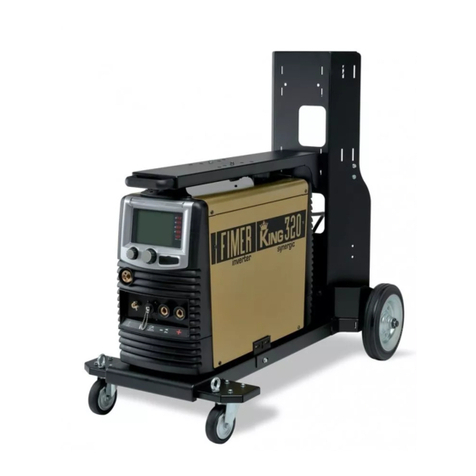
Fimer
Fimer King 320 User manual

Fimer
Fimer KRONOS 500 dual-pulse User manual

Fimer
Fimer T252 User manual
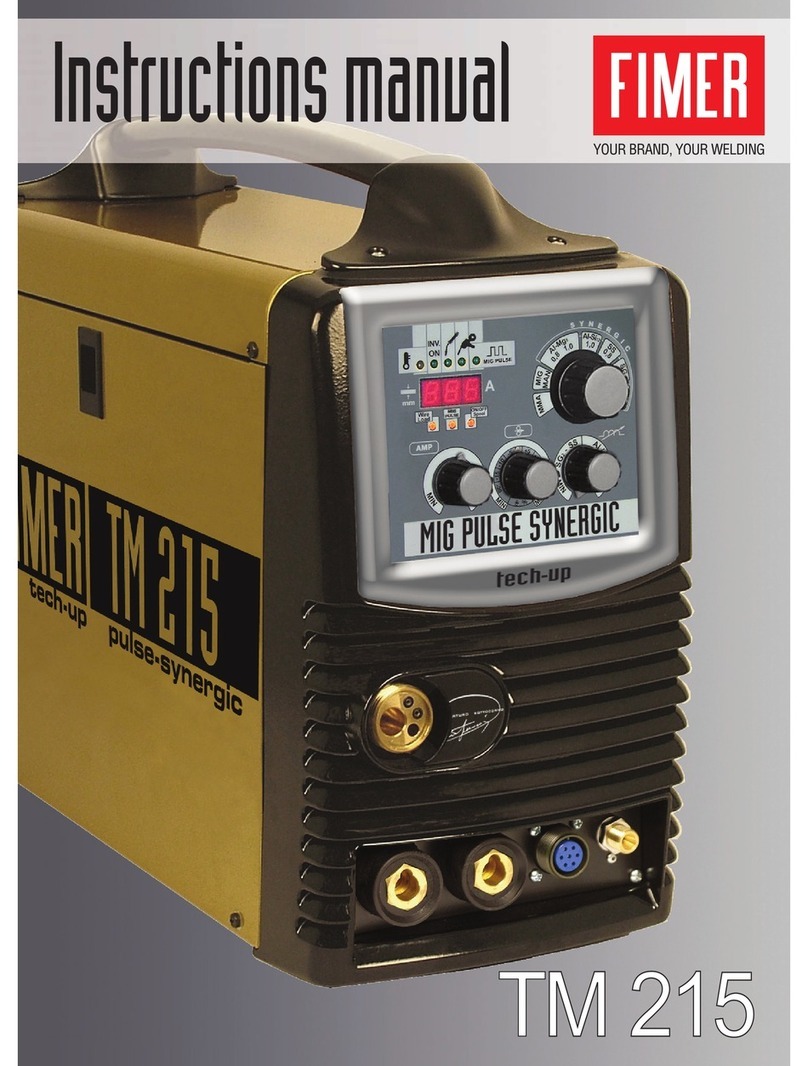
Fimer
Fimer TM 215 User manual
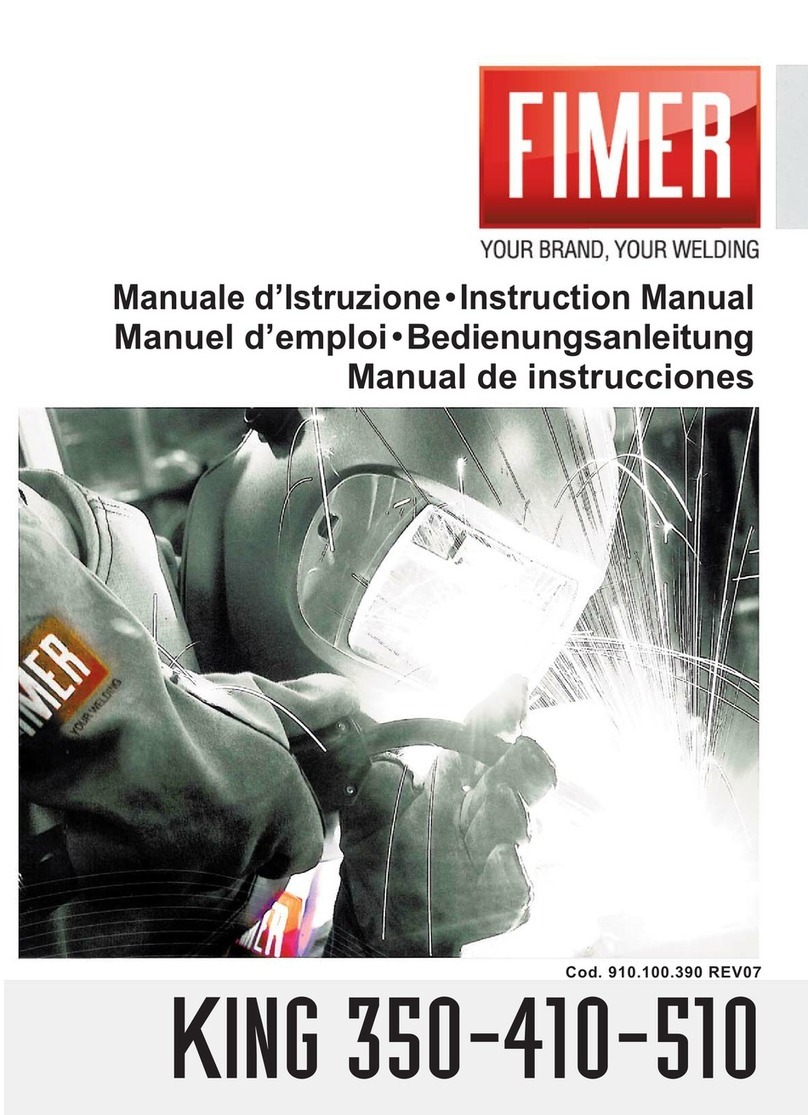
Fimer
Fimer King 350 User manual
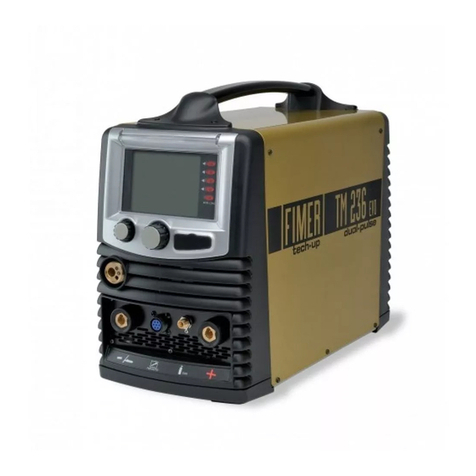
Fimer
Fimer TM 236 User manual
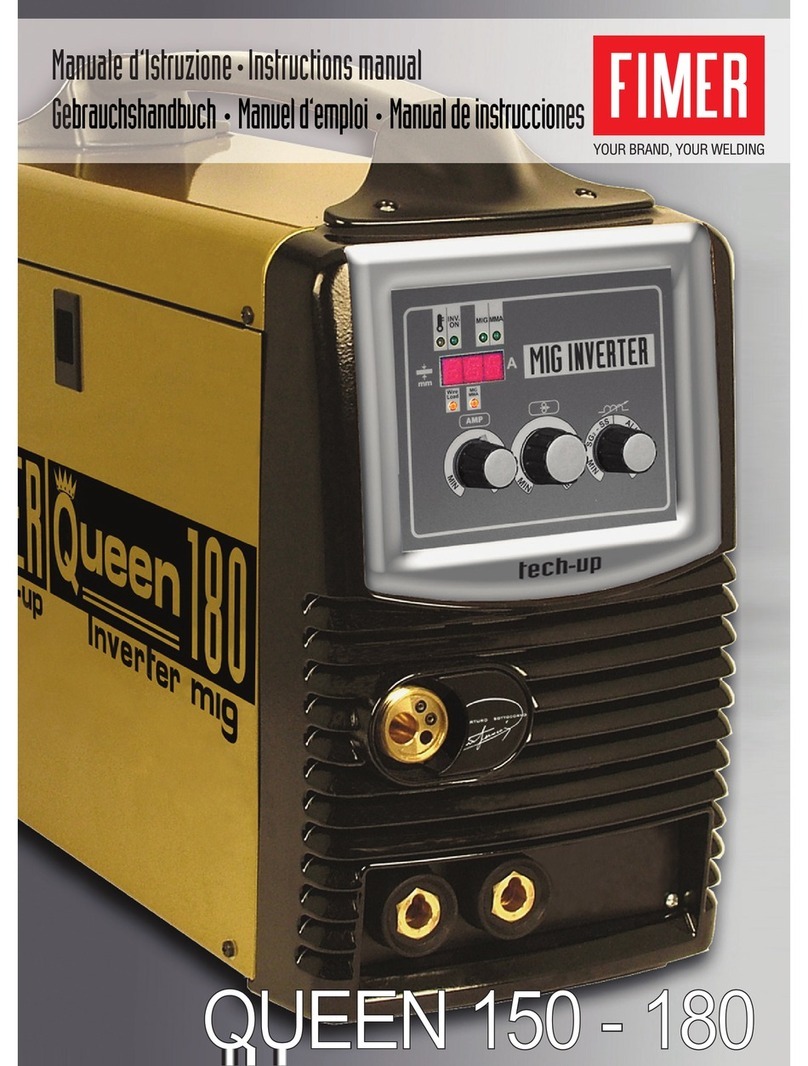
Fimer
Fimer QUEEN 180 User manual

Fimer
Fimer TT165 AC/DC User manual
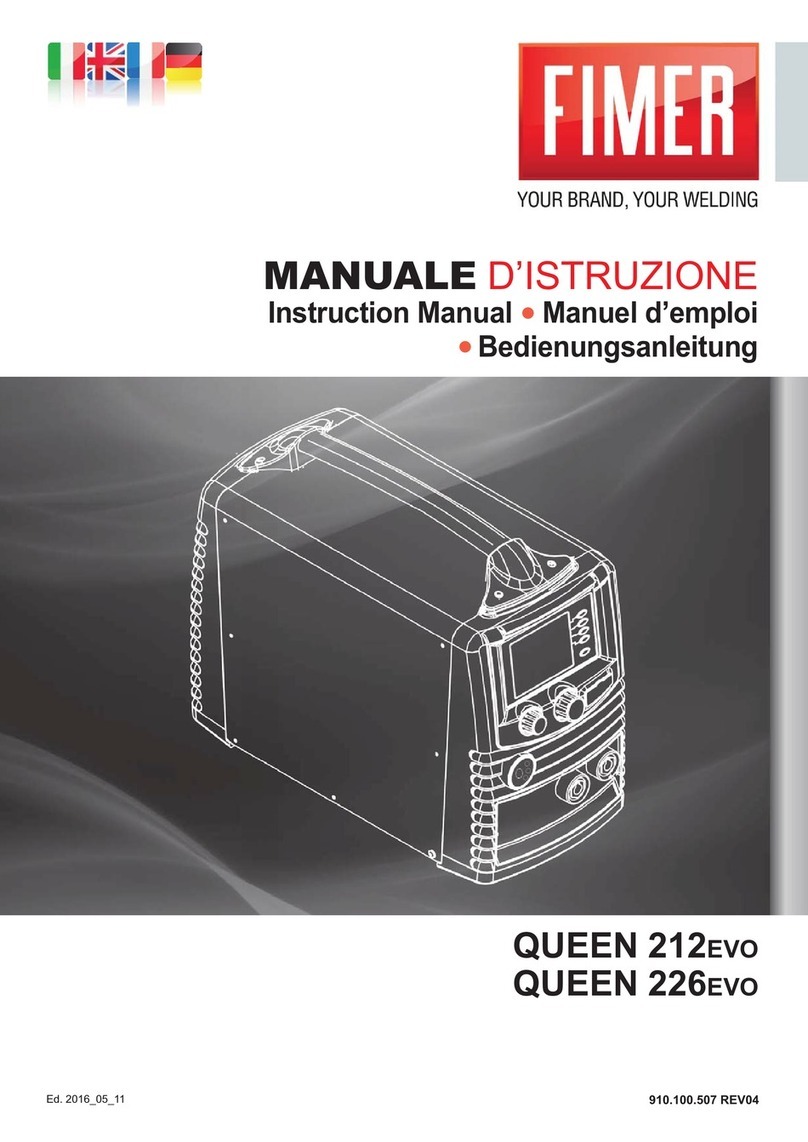
Fimer
Fimer QUEEN 212EVO User manual
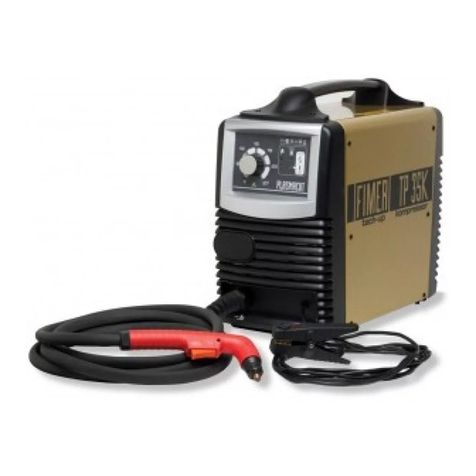
Fimer
Fimer TP 35K User manual
Popular Welding System manuals by other brands

Lincoln Electric
Lincoln Electric WELDMARK 225 Operator's manual

FRONIUS
FRONIUS TPS/i Robotics PushPull CMT operating instructions

Hobart
Hobart STICKMATE LX owner's manual

Miller
Miller Maxstar 150 STH owner's manual

Leister
Leister UNIPLAN 300 manual

Elektra Beckum
Elektra Beckum SDV 250 RC operating instructions

